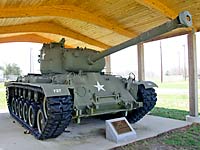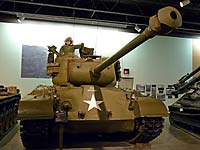| page 1 of 3 |
| Wright Museum - T26E3 Pershing Tank
Bill Maloney 11/20/2009 |
| page 1 of 3 |
M26 and M46 Tanks at other Military Museums |
|
 |
 |
| An M26 Pershing Tank at the Fort Dix Army Reserve Mobilization Museum | An M26 Pershing Tank at the Patton Museum in Fort Knox, KY |
Length: 28 feet, 4 inches
Width: 11 feet, 6 inch
Height: 9 feet, 1 inches
Crew: 5
Weight: 46 Tons
Max Speed: 25 mph
Range: 100 miles
Armor: 4.33" Frontal
Powerplant: Ford GAF V8 Water Cooled Gas Engine 500hp
Fuel Capacity: 183 gallons
Armament:
90mm L/53 Gun M3, 70 Rounds, Muzzle Velocity 2,700fps
One .30Cal Coax Machine Gun
One .30Cal Bow Machine Gun
One .50Cal Browning M2 Cupola Mounted Machine Gun
Entered Service: 1945
This particular T26E3 Pershing Tank is a survivor of the battle for the Bridge at Remagen.
Dierk Lurbke of Cologne, Germany has put together an outstanding page covering the duel between a T26E3 Pershing Tank and a German Panzer Mk V Panther Tank in Cologne towards the end of WWII. The Panther Tank had easily dealt with a Sherman tank which was advancing down a street in Cologne, killing two of it's crew. The Pershing was ordered to go down an adjacent street and poke just enough of the hull into the intersection to be able to get off a shot at the Panther tank. As the T26E3 tank entered the intersection the tank commander realized the German tank's gun barrel was already swinging his way. Rather than stopping he continued moving into the intersection and fired on the move. The Pershing had something that the German tanks didn't - a gyroscopically stabilized gun mount, which would keep the barrel more or less steady on the target while still moving. Dierk has video footage of the battle, with shots of the Sherman tank shortly after being hit and the surviving crew members bailing out, and also of the Panther tank being hit 3 times and burning fiercely. Two surviving Panzer Mk V Panther Tanks can be found at the US Army Ordnance Museum in Aberdeen, MD. A restored M4 Sherman Tank can also be found at the Ordnance Museum.
Dierk goes much further with frame by frame images of the Pershing Tank's rounds penetrating the Mk V Panther's hull and turret armor. There are several short popup videos detailing different points in the battle. One sequence shows the Pershing firing, and in another window shows the Panther being struck at the very same moment (this is footage taken by two different US Army combat photographers). It graphically illustrates the power and magnitude of the muzzle blast from the T26E3's high velocity 90mm main gun.
The Pershing Tank was the only US Army tank that was able to fight the German Panzer Mk V Panther or Panzer Mk VI Tiger I tanks on an equal basis. The M4 Sherman medium tank was well under armored and under gunned in comparison to the heavy Panzer Tanks. Even the German Panzer Mk IV medium tank with its high velocity 75mm gun could knock out the Shermans well beyond the range the M4s needed to be to counter the Mk IV panzers. In Belton Y. Cooper's excellent book, "Death Traps", he writes that the M4 Sherman tank in the battle for Normandy had a loss rate of 580% (that is not a typo). That includes the hundreds of US Army tanks that had been knocked out and recovered and repaired. Armor penetration holes would be welded up and the remains of the tanker crews would be cleaned out of the interiors and the interiors freshly painted. Mechanical and armament repairs would be made and the tanks put back into action with new crews, many of which would be taken right out of the infantry ranks and put into battle with only a few hours of training. Had the M26 Pershing been available earlier, many, many US Army tank crews that were sacrificed would have survived the war. The Pershing's development and deployment had been held up partly by the arrogance of General George S. Patton, who felt there was no need for a heavier tank than the Sherman, and that superior numbers would prevail. On the last point he was right, but at a terrible cost to US tanker crews.
Here's a video of a US Army Pershing Tank with a Ford GAF Tank engine starting up. Although the video states this is a Ford GAA tank engine, it is more likely that it is a Ford GAF engine as the GAA engines were designed for the M4 Sherman tank.
Another video of a Pershing Tank with a Ford GAF V8 tank engine moving out of a garage.
A Ford GAF tank engine of the type used in the US Pershing tank can be found at the American Armored Forces Museum in Danville, VA.
Wright Museum Main Page
Military & Aviation Museums Main Page